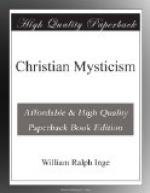[Footnote 178: Cf. Richard of St. Victor, de Praep. Anim. 83, “ascendat per semetipsum super semetipsum.”]
[Footnote 179: The same is true of our attitude towards external nature. We are always trying to rise from the shadow to the substance, from the symbol to the thing symbolised, and so far the followers of the negative road are right; but the life of Mysticism (on this side) consists in the process of spiritualising our impressions; and to regard the process as completed is to lose shadow and substance together.]
[Footnote 180: It may be objected that I have misused the term via negativa, which is merely the line of argument which establishes the transcendence of God, as the “affirmative road” establishes His immanence. I am far from wishing to depreciate a method which when rightly used is a safeguard against Pantheism, but the whole history of mediaeval Mysticism shows how mischievous it is when followed exclusively.]
[Footnote 181: See Vaughan, Hours with the Mystics, vol. i. p. 58.]
[Footnote 182: Seth, Hegelianism and Personality, states this more strongly. He argues that “the ultimate goal of Realism is a thorough-going Pantheism.” God is regarded as the summum genus, the ultimate Substance of which all existing things are accidents. The genus inheres in the species, and the species in individuals, as an entity common to all and identical in each, an entity to which individual differences adhere as accidents.]
[Footnote 183: McTaggart, Studies in Hegelian Dialectic, p. 159 sq., argues that Hegel means that the Absolute Idea exists eternally in its full perfection. There can be no real development in time. “Infinite time is a false infinite of endless aggregation.” The whole discussion is very instructive and interesting.]
[Footnote 184: So Lasson says well, in his book on Meister Eckhart, “Mysticism views everything from the standpoint of teleology, while Pantheism generally stops at causality.”]
[Footnote 185: As, for instance, Leslie Stephen tries to do in his Agnostic’s Apology.]
[Footnote 186: The system of Spinoza, based on the canon, “Omnis determinatio est negatio,” proceeds by wiping out all dividing lines, which he regards as illusions, in order to reach the ultimate truth of things. This, as Hegel showed, is acosmism rather than Pantheism, and certainly not “atheism.” The method of Spinoza should have led him, as the same method led Dionysius, to define God as [Greek: hyperousios aoristia]. He only escapes this conclusion by an inconsistency. See E. Caird, Evolution of Religion, vol. i. pp. 104, 105.]
[Footnote 187: There is a third system which is called pantheistic; but as it has nothing to do with Mysticism, I need not try to determine whether it deserves the name or not. It is that which deifies physical law. Sometimes it is “materialism grown sentimental,” as it has been lately described; sometimes it issues in stern Fatalism. This is Stoicism; and high Calvinism is simply Christian Stoicism. It has been called pantheistic, because it admits only one Will in the universe.]




